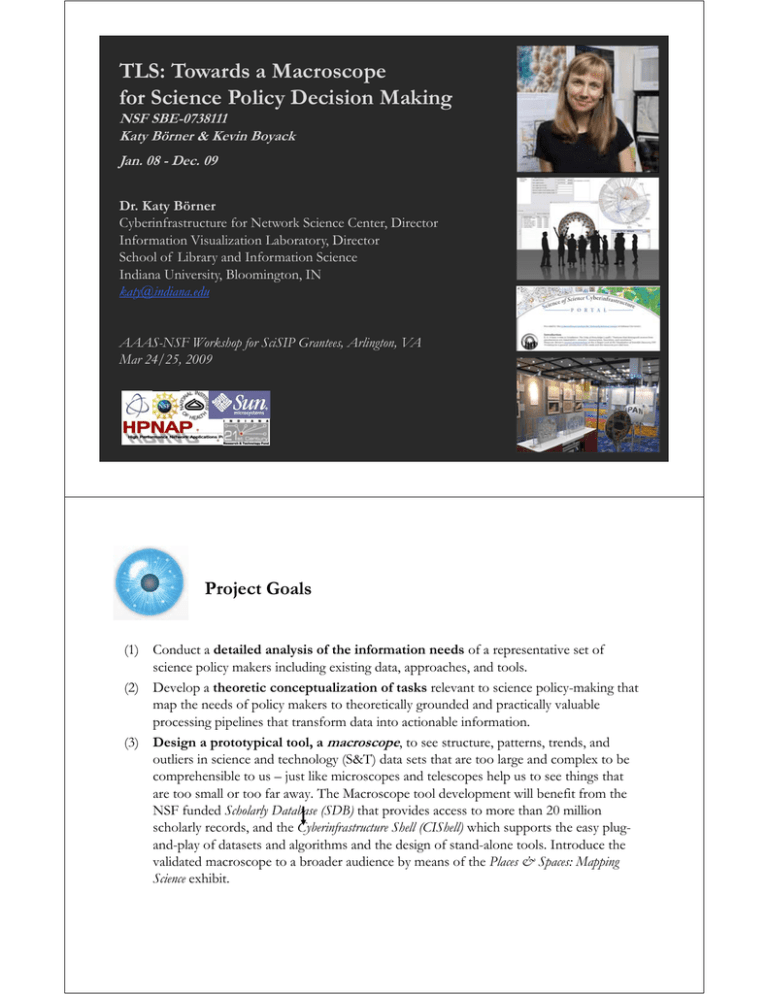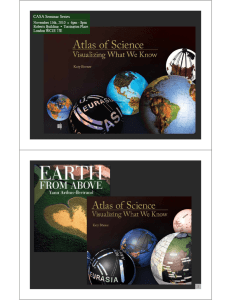TLS: Towards a Macroscope for Science Policy Decision Making
advertisement

TLS: Towards a Macroscope for Science Policy Decision Making NSF SBE-0738111 Katy Börner & Kevin Boyack J 08 - Dec. Jan. D 09 Dr. Katy Börner Cyberinfrastructure for Network Science Center, Director Information Visualization Laboratory, Director School of Library and Information Science Indiana d University, U v s y, Bloomington, g , IN N katy@indiana.edu AAAS-NSF AAAS NSF Workshop W k h p for f SciSIP S iSIP Grantees, G t Arlington, A li t VA Mar 24/25, 2009 Project Goals (1) Conduct a detailed analysis of the information needs of a representative set of science policy makers including existing data, approaches, and tools. (2) Develop a theoretic conceptualization of tasks relevant to science policy-making that map the needs of policy makers to theoretically grounded and practically valuable processing pipelines that transform data into actionable information. (3) Design a prototypical tool, a macroscope, to see structure, patterns, trends, and outliers in science and technology (S&T) data sets that are too large and complex to be comprehensible omprehensible to uss – just j st like mi microscopes ros opes and nd teles telescopes opes help uss to see things that th t are too small or too far away. The Macroscope tool development will benefit from the NSF funded Scholarly Database (SDB) that provides access to more than 20 million scholarly records, and the Cyberinfrastructure Shell (CIShell) which supports the easy plugand-play of datasets and algorithms and the design of stand-alone tools. Introduce the validated macroscope to a broader audience by means of the Places & Spaces: Mapping Science exhibit. 1. Detailed Needs Analysis A ttotal t l off 34 science i policy li makers k andd researchers h att university i it campus level l l (8), (8) program officer level (12), and division director level at national, state, and private foundations (10) as well as science policy makers from Europe and Asia (4) were interviewed between Feb Feb. 8th 8th, 2008 and Oct. Oct 2nd, 2nd 2008. 2008 Each interview comprised a 40 min, audio-taped, informal discussion on specific iinformation f ti needs, d datasets d t t andd tools t l currently tl used, d andd information i f ti on what h ta 'dream tool' might look and feel like. There is also a pre-interview questionnaire to acquire demographics and a post-interview questionnaire to get input on priorities. Data compilation is in progress, should be completed in July 2009, and will be submitted as a journal paper. Some data excerpts are given here. In the Post-Questionnaire Subjects were asked: “What are initial thoughts regarding the utility of science of science studies for improving decision making? How would access to datasets and tool speed up and increase the quality of your work?” Excerpts of answers: Two areas have great potential: Understanding S&T as a dynamic system, means to d l visualize display, l and d manipulate l llarge interrelated l d amounts off data d in maps that h allow ll better intuitive understanding. Look for new areas of research to encourage growth/broader impacts of research-how to assess/ transformative science--what scientific results transformed the field or created t d a new field/ fi ld/ finding fi di panelists/reviews/ li t / i / how h much h to t invested i t d until til a plateau l t in knowledge generation is reached/how to define programs in the division. Scientometrics as cartography of the evolution of scientific practice that no single actor (even Nobel Laureates) can have. Databases provide a macro-view of the whole of scientific field and its structure. structure This is needed to make rational decision at the level of countries/states/provinces/regions. Understanding where funded scientists are positioned in the global map of science. Self-knowledge about effects of funding/ self-knowledge about how to improve funding schemes schemes. Ability to see connections between people and ideas, integrate research findings, metadata, clustering career measurement, workforce models, impact (economic/social) on society-interactions between levels of science; lab, institution, agency, Fed Budget, public interests. It would be valuable to have tools that would allow one automatically to generate cocitation, co-authorship maps…I am particularly interested in network dynamics. It would enable more quantitative decision making in place of an "impression-based" system, and provide a way to track trends, which is not done now. When NSF started SciSIP, SciSIP I was skeptical skeptical, but I am more disposed to the idea behind it now although I still don't have a clear idea what scientific metrics will be…..how they will apply across disciplines and whether it's really possible to predict with any accuracy the consequences of any particular decision of a grant award. SoS p potentiallyy useful to policymakers p y byy providing p g qualitative q and quantitative q data on the impacts of science toward government policy goals…ideally these studies would enable policy makers to make better decisions for linking science to progress toward policy goals. Tracking faculty's work over time to determine what factors get in the way of productivity and which enhance, e.g. course-releases to allow more time--does this really work or do people who want to achieve do so in spite of barriers. I'm not sure that this has relevance to my decision-making. There is a huge need for more reliable data about my organization and similar ones, but that seems distinct f from data d t andd tools t l to t study t d science. i It would assist me enormously. Help to give precedents that would rationalize decisions--help to assess research outside one's major area. Ways of assessing innovation, ways of assessing interactions ( (among researchers, h across areas, outside id academia). d i ) It would allow me to answer questions from members of congress provide visual presentations of data for them. Very positive step--could fill important need in understanding innovation systems and organizations. i i 2. Conceptualizations of Science See Special Issue of Journal of I f Informetrics, t i 3(3), 3(3) Jan J 2009. 2009 Editorial is available at http://ivl.slis.indiana.edu/km/pub/2009-borner-scharnhorst-joi-sos-intro.pdf 3. Macroscope Tool Benefits from and extends the Scholarly Database at IU “F “From Data D t Silos Sil to t Wind Wi d Chimes” Chi ” Interlink creators, data, software/tools, publications, patents, funding, etc. Create public databases that any scholar can use. Share the burden of data cleaning l and d ffederation. d Scholarly Database: # Records & Years Covered Datasets available via the Scholarly Database (* internally) Dataset # Records Years Covered Updated Restricted Access Medline 17,764,826 1898-2008 PhysRev 398,005 1893-2006 Yes PNAS 16,167 1997-2002 Yes JJCR 59,078 1974, 1979, 1984, 1989 1994-2004 Yes 3, 710,952 1976-2008 Yes* NSF 174,835 , 1985-2002 Yes* NIH 1,043,804 1961-2002 Yes* Total 23,167,642 1893-2006 4 USPTO Aim for comprehensive time, geospatial, and topic coverage. Yes 3 Grant-Article Linking g Institute NCI NHLBI NIGMS NIDDK NIAID NINDS NIMH NCRR NIA NICHD NIDA NEI NIEHS NIAMS NIAAA NIDCD NIDCR NIBIB FIC NINR NHGRI NCCAM NLM NCMHHD WHI Others Totals NIH ggrant data from CRISP and RaDiUS were linked to Medline papers using the grant information strings in Medline (dirty data using dozens of formats) 94% of grant strings were matched with a ggrant number Enables future input-output studies possible matches 93,897 82,525 58 749 58,749 52,390 51,953 37,054 36,859 31,373 27,424 26,691 , 21,145 18,835 16,220 15,401 10,643 9,200 9,094 4,381 2,813 2,661 2,559 1,724 1,609 559 205 598 616,562 % matched 92.0% 93.5% 95 3% 95.3% 95.4% 92.5% 94.9% 93.8% 95.1% 93.9% 93.1% 95.3% 95.6% 94.3% 93.4% 94.3% 95.0% 94.3% 95.5% 87.7% 88.2% 93.2% 93.0% 85.6% 74.2% 97 1% 97.1% 4.5% 93.7% unambig 82,539 72,172 49 886 49,886 45,857 43,087 32,774 31,392 27,601 24,104 22,596 , 18,234 16,183 14,280 13,522 8,885 7,706 8,025 4,124 2,404 2,314 2,098 1,580 1,362 413 199 27 533,364 ambig 3,883 4,952 6 103 6,103 4,125 4,976 2,377 3,186 2,233 1,659 2,248 , 1,924 1,824 1,008 856 1,154 1,033 554 60 64 32 286 23 15 2 0 0 44,577 no match 7,475 5,401 2 760 2,760 2,408 3,890 1,903 2,281 1,539 1,661 1,847 , 987 828 932 1,023 604 461 515 197 345 315 175 121 232 144 6 571 38,621 # unique grants 11,314 9,600 8 421 8,421 6,987 8,348 5,954 6,092 1,470 3,369 3,975 , 3,394 2,604 1,540 2,236 1,700 1,916 1,536 727 547 784 492 331 232 65 41 15 83,690 # unique articles 51,521 41,901 43 640 43,640 31,405 30,149 24,467 21,401 24,271 16,489 17,041 , 11,812 10,610 10,064 9,931 5,973 5,830 5,922 3,415 2,178 1,996 2,023 1,335 1,109 373 35 26 374,917 % multiinst arts 36.1% 41.6% 35 3% 35.3% 49.5% 42.8% 46.7% 40.0% 72.7% 50.4% 49.3% 43.1% 27.8% 52.1% 50.3% 43.3% 29.9% 38.6% 56.5% 54.1% 23.2% 50.3% 48.5% 35.1% 62.5% 40 0% 40.0% 46.2% 44.0% CRISP 1990-2002 NIH Grants 1990-2005 1 rec/grant/ year RaDiUS NIH 1998-2005 Match grant info NIH Grants 1990-2005 1 rec/grant Medline 2002-2006 (grant info) Map PMID to GRANT id Subsequentt Analysis Subseque a ys s From o Matches atc es Short grants (1-2 years) produce more papers per year than long grants (3-15 years). Data not normalized for grant size. Acknowledgement of NIH funding in Medline Medline-indexed indexed articles does seem to be reasonably complete. “None” category size consistent with other analyses – these are not “missing NIH” data. 0.50 100000 1000 100 10 0 0.45 0.40 0.35 0.30 0.25 0.20 0.15 0.10 0.05 Number of articles (unambiguous) / grant / year 46.0 - 100 21.0 - 46.0 4.6 - 10.0 10.0 - 21.0 2.1 - 4.6 1.0 - 2.1 0.46-1.0 0.21 - 0.46 0.10 - 0.21 0 1 0.0 - 0.10 Numb ber of grants 10000 Fraction of Articles 1 2 years 1-2 3-4 years 5-7 years 8-10 years 11-15 yrs 16+ yrs 0.00 PHS PHS + othGOV PHS PHS + + othGOV + othGOV othGOV + non-USG non-USG non-USG non-USG Funding Type none Scholarly Database: Web Interface Anybody can register for free at https://sdb.slis.indiana.edu to search the about 23 million records and download results as data dumps. p Currently the system has over 100 registered users from academia, industry, and government from over 60 institutions and four continents. 3. Macroscope Tool Builds on and extends the Network Workbench but will ultimately be ‘packaged’ as a SciPolicy’ branded tool. The Network Workbench (NWB) tool supports researchers, educators, and practitioners interested in the study of biomedical, biomedical social and behavioral science, physics, and other networks. In Feb. 2009, the tool p provides more 100 plugins that support the preprocessing, analysis, modeling, and visualization of networks. M More than h 40 off these h plugins l i can be applied or were specifically designed for S&T studies. It has been downloaded more than 18,000 times since Dec. 2006. http://nwb.slis.indiana.edu/ See https://nwb.slis.indiana.edu/community SciPolicy Studies - Using Open Data and Open Code July 1st, 2008 Mapping Science Exhibit – 10 Iterations in 10 years http://scimaps.org/ The Power of Maps (2005) Science Maps for Economic Decision Makers (2008) The Power of Reference Systems (2006) Science Maps for Science Policy Makers (2009) Science Maps for Scholars (2010) Science Maps as Visual Interfaces to Digital Libraries (2011) Science Maps for Kids (2012) Science Forecasts (2013) The Power of Forecasts (2007) How to Lie with Science Maps (2014) Exhibit has been shown in 49 venues on four continents. Also at - NSF, 10th Floor, 4201 Wilson Boulevard, Arlington, VA. - Chinese Academy of Sciences, China, May 17-Nov. 15, 2008. - University of Alberta, Edmonton, Canada, Nov 10-Jan 31, 2009 - Center of Advanced European Studies and Research, Bonn, Germany, Dec. 11-19, 2008. 15 http://sci.slis.indiana.edu All papers, maps, cyberinfrastructures, talks, press are linked from http://cns.slis.indiana.edu






